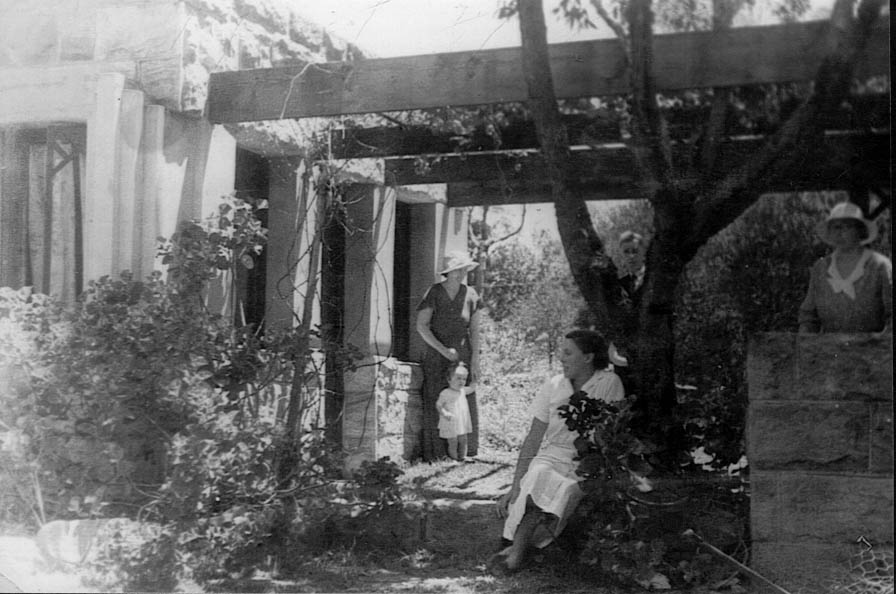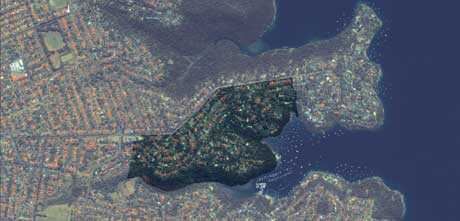The legacy of the Griffins’ vision in Castlecrag can be experienced in the physical environment of the streetscapes and landscapes, in the reserves and walkways, and in the buildings and the amphitheatre. It is evidenced also in the community’s memorials to Walter Burley Griffin — the planting of trees along Edinburgh Road by the Progress Association and Marion after Griffin’s death, the Bim Hilder fountain at the intersection of Edinburgh Road and Sortie Port and the bronze sculpture of Griffin outside the Griffin Centre shops. Those who knew the Griffins remembered that time when the Griffins were central to a group of activists and thinkers who formed within Castlecrag a truly unique community.
Physical environment
The 15 houses built to Griffin’s designs are important parts of the Griffin legacy at Castlecrag, along with the shops (now called the Griffin Centre) and the two houses approved by, but not designed by, Griffin.
To preserve his vision for the future of Castlecrag, Griffin instigated a system of covenants over the residential allotments within the estate. These covenants were to control building so as to prevent unsympathetic development as well as to protect the native flora and fauna.
The characteristic narrow roadways follow the contours of the rugged landscape in beautiful sweeping curves. The continuous and extensive foreshore reserves and numerous bushland reserves connected by their network of meandering walkways remain intact and are used and enjoyed by residents and visitors alike. Mostly the absence of fences still predominates and this allows a shared landscape as the Griffins intended, with the merging of public and private spaces to create the unique effect of houses nestling within the landscape. In Griffin’s words this was ‘so that each individual can feel the whole landscape is his’.
The numerous reserves provide a range of environments. They are mainly beautiful bushland retreats. Many have dramatic rock outcrops, views and vistas, and a couple have playgrounds. Cortile Reserve has tennis courts and Castlehaven Reserve has the unique open-air amphitheatre.
Social legacy and community involvement
At Castlecrag the Griffins were able to implement their community ideas and an important aspect of their legacy there, although less tangible but still palpable today, is its community spirit. This is evidenced in the numerous community groups and activities in the peninsular suburb. Music, playreading and discussion groups, treeplanting and bushland conservation activities, and also the open-air Haven Valley Scenic Theatre, were established by the Griffins and their associates in the 1920s and 1930s.
Today the Castlecrag Progress Association, the Castlecrag Conservation Society, the Haven Amphitheatre Committee and the Walter Burley Griffin Society continue that community spirit initiated and inspired by the Griffins.
Conserving the legacy
To assist in the conservation of the Griffin legacy at Castlecrag the local government council, Willoughby City Council, has undertaken a lengthy process of study and community consultation to develop the Willoughby Local Environment Plan 1995 (WLEP95), which was formally gazetted on 15 November 1995. WLEP95 established 12 conservation areas within Willoughby City, one of the most widely recognised of which is the Griffin Conservation Area in Castlecrag.
Within the Griffin Conservation Area, the most significant objective of the heritage controls is to ensure the subordination of buildings to the landscape, as well as the preservation of amenity, landscape, views and vistas.
Some of Griffin’s Castlecrag buildings are listed on the NSW State Heritage Register, namely the Duncan house (listed 1999) and Fishwick house (2006), as well as the Willoughby Incinerator (1999), while all of Griffin’s Castlecrag buildings are listed as local heritage items on the Willoughby Council planning instrument WLEP2012. In addition, all Griffin’s NSW buildings are on the Australian Institute of Architects (NSW Chapter) Register of Significant Buildings (listed from the late 1970s onwards) and the subdivision of Castlecrag and Griffin’s Castlecrag houses were listed on the DocoMomo’s international Register in 2000.
In 1997 a Plan of Management for the Griffin Reserves at Castlecrag was prepared, and updated in 2017. This plan seeks to regenerate and maintain the network of reserves and the surviving canopy of the urban forest that give a bushland atmosphere to the suburb, despite past depredations and neglect.
Heritage initiatives
The conservation of the Griffin houses in Castlecrag and recognition of the heritage importance of the houses and the surviving Griffin landscape planning have made significant advances in the last two decades, due much to the energy and activism of the local community.
Promoting and protecting Griffin heritage has been a key priority for the Castlecrag Progress Association, the Walter Burley Griffin Society and members of the local community. In the early 1960s a fund-raising appeal was initiated by the Castlecrag Community Centre Committee for a fountain to honour Walter Burley Griffin. Local sculptor and friend of Griffin, Bim Hilder, was commissioned to design this significant work. The fountain was officially opened on 23 October 1965 during the celebrations of the Centenary of Willoughby Municipality.
In 1974 local residents and conservationists Beverley Blacklock and Judy Messer formed a group to clear the massive overgrowth of weeds and building rubble from the Haven Amphitheatre. A new timber stage and changing facilities designed by local architect Robert Sheldon were constructed and the new Haven Amphitheatre was ready for its first production during the ‘Castlecrag Heritage Festival’ in April 1976. The inaugural play was Salome, directed by Howard Rubie with a cast of local residents, and actors from the Artists Group Theatre. An important production was Lindy Batterham’s play Marion’s Gift, performed on 17 October 1993 to commemorate the 60th anniversary of Marion Mahony Griffin giving a deed of trust for the Haven Amphitheatre and the foreshore Castlehaven Reserve to Willoughby Council in trust for the community.
Over 50 local residents were involved in the production in which the giant ‘Walter’ and ‘Marion’ puppets had leading roles.
The Castlecrag Heritage Festival was part of the Australian American Festival of Sydney to celebrate the US Bicentenary in 1976. It featured an exhibition titled ‘Walter Burley Griffin and his Castlecrag’, while several of the Griffin houses were open for inspection. This event was influential in developing awareness among new residents of the role played by the Griffins in creating the unique character of their suburb.
Dianne Street, chairperson of the Castlecrag Heritage & Classification Committee, and colleagues commenced negotiations with the National Trust in 1974 to have the Griffin Castlecrag estates classified as a historical area. The National Trust of Australia (NSW Branch) formally classified the ‘Castlecrag Urban Conservation Area’ in 1978 to recognise ‘Griffin’s sensitivity towards the site and his intentions to provide an environment in which Man could be at peace with Nature’.
The restored walkways and reserves now see frequent use by local residents and visitors, including regular guided tours of the Griffin Conservation Area organised by local community groups and the Australian Architecture Association. Local residents are encouraged to join Bush Care Groups to undertake restoration work in nearby reserves, while contractors engaged by Council have also carried out extensive bush restoration work in the reserves.
The contribution by Willoughby Council and community to restore the public spaces and heritage of the Griffin Conservation Area over the past 20 years has been a major factor in the increased public awareness of, and participation in, the Griffin legacy. Willoughby City Council’s planning controls, updated to become WLEP2012, along with WDCP Part H specific to the Griffin Conservation Area, contain detailed Management Policies and Controls designed to provide residents with a clear and transparent framework in which to plan new developments that meet the community interest and help to keep Castlecrag a special place.
Castlecrag today is much altered from the idyllic bushland retreat evoked in the Griffins’ lyrical 1927 promotional film ‘Beautiful Middle Harbour’. Yet it is still a special place and the ideas the Griffins so tirelessly expounded — ideas about the primacy of nature, the importance of community and our connectedness to each other and to the environment — resonate with even more relevance today. After the Griffins, Castlecrag was subjected to a different kind of development, yet many of its subtle and idiosyncratic qualities survive. The community spirit of the early days has been carried on through the dedication and commitment of those who appreciate and care for the distinctive environment of Castlecrag.
Castlecrag continues to demonstrate the Griffins’ deep respect for the natural landscape and their ideal of a community living in harmony with its beautiful setting.
Author
Martin O’Donoghue is a senior architect in a midsized practice working on projects throughout New South Wales. He is interested in all forms of art and architecture including painting, dance, theatre and cinema. He has been a resident of Castlecrag since 1989, and a committee member of the Walter Burley Griffin Society.
Further reading
Leslie, Esther (comp), The Suburb of Castlecrag: a community history. Sydney, Willoughby Municipal Council, 1988.
Walker, Meredith, Kabos, Adrienne and Weirick, James, Building for Nature: Walter Burley Griffin and Castlecrag. Castlecrag, Walter Burley Griffin Society, 1994.
Walker, Meredith, ‘The Development at Castlecrag’, in Turnbull, Jeff and Navaretti, Peter Y (eds), The Griffins in Australia and India: the complete works and projects of Walter Burley Griffin and Marion Mahony Griffin. Melbourne, Miegunyah Press (Melbourne University Press), 1998: 74–85.
Walter Burley Griffin Society, The Griffin Legacy: Castlecrag Heritage, (brochure pdf 752kb). Sydney, Walter Burley Griffin Society & NSW Heritage Office, 2004.
Watson, Anne (ed), Visionaries in Suburbia – Griffin Houses in the Sydney Landscape. Walter Burley Griffin Society, 2015.



